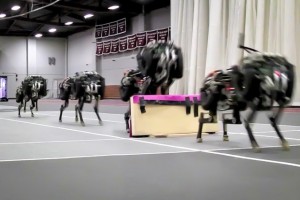Peter Lobner
The two primary goals of the M3 program are:
- Create a significantly improved scientific framework for the rapid design and fabrication of robot systems and greatly enhance robot mobility and manipulation in natural environments.
- Significantly improve robot capabilities through fundamentally new approaches to the engineering of better design tools and fabrication methods.
More details on the M3 program are presented on the following DARPA website:
http://www.darpa.mil/our_work/dso/programs/maximum_mobility_and_manipulation_(m3).aspx
In September 2012, the DARPA / Boston Dynamics / MIT Cheetah 4-legged robot, being developed under the M3 program, reached a top speed of over 29 mph in a tethered test on a treadmill, exceeding the fastest speed ever run by a human, Usain Bolt, at 27.78 mph in a 20-meter sprint. You can see a video of this tethered test of the Cheetah at the following link:
https://www.youtube.com/watch?v=YqpO58x7vuE
In May 2015, the Cheetah demonstrated it’s ability to hurdle obstacles up to 18”tall in both tethered treadmill and untethered indoor track tests while running at an average speed of about 5 mph.
You can read the article and see a video of this test at the following link:
https://newsoffice.mit.edu/2015/cheetah-robot-lands-running-jump-0529
As described in this article:
“To get a running jump, the robot plans out its path, much like a human runner: As it detects an approaching obstacle, it estimates that object’s height and distance. The robot gauges the best position from which to jump, and adjusts its stride to land just short of the obstacle, before exerting enough force to push up and over. Based on the obstacle’s height, the robot then applies a certain amount of force to land safely, before resuming its initial pace.”
On the treadmill, the Cheetah only had about a meter in which to detect the obstacle and then plan and execute the jump. Nonetheless, the Cheetah cleared the obstacles about 70% of the time. I can only imagine that a human runner on that same treadmill might not have performed much better. In the untethered tests on an indoor track, the Cheetah cleared the obstacles about 90% of the time. Future tests will explore the ability of the Cheetah to clear hurdles on softer terrain.
You can see more high-mobility robots being developed by Boston Dynamics at the following link:
http://www.bostondynamics.com/index.html
These robots include:
- Atlas: a high mobility, humanoid (bipedal) robot designed to negotiate outdoor, rough terrain. Atlas will be one of the competitors in the DARPA Robotics Challenge (DRC) Finals that will take place on 5 – 6 June 2015 at Fairplex in Pomona, California. See my 23 March 2015 post for more information on the DRC Finals.
- LS3: a rough-terrain quadruped robot designed to go anywhere soldiers go on foot, helping carry their load.
- PETMAN: an anthropomorphic (bipedal) robot designed for testing chemical protection clothing.
- BigDog: a rough-terrain quadruped robot that walks, runs, climbs and carries heavy loads.
- Sand Flea: a small robot that drives like an remote-controlled car on flat terrain, but can jump 30 ft. into the air to overcome obstacles
- RHex: a six-legged, high mobility robot designed to climb in rock fields, mud, sand, vegetation, fallen telephone poles, railroad tracks, and up slopes and stairways.
- RiSE: a robot that uses micro-claws to climb vertical terrain such as walls, trees and fences.
- LittleDog: a quadruped robot designed for research on learning locomotion.
